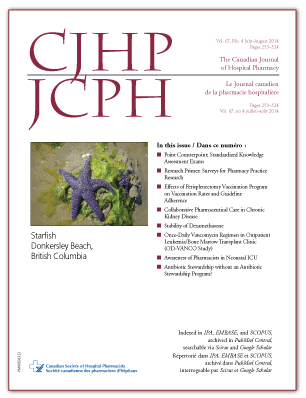Evaluation of a Once-Daily Vancomycin Regimen in an Outpatient Leukemia/Bone Marrow Transplant Clinic (OD-VANCO Study)
DOI:
https://doi.org/10.4212/cjhp.v67i4.1372Keywords:
once-daily vancomycin, febrile neutropenia, nomogram, therapeutic drug monitoring, administration uniquotidienne de vancomycine, neutropénie fébrile, nomogramme, suivi thérapeutique pharmacologiqueAbstract
ABSTRACT
Background: The Leukemia/Bone Marrow Transplant Program of British Columbia manages patients with high-risk febrile neutropenia and those with non-neutropenic immunocompromised states in an outpatient clinic setting. Because the program treats outpatients only, once-daily administration of IV antibiotics is desirable. A high-dose, once-daily vancomycin nomogram was developed and implemented as part of the antibiotic treatment regimen.
Objective: To determine if therapeutic vancomycin trough levels could be achieved with a high-dose, once-daily regimen in this outpatient setting.
Methods: A prospective, single-centre, observational cohort study was conducted over a 7-month period. Outpatients in the Leukemia/Bone Marrow Transplant Program were started on IV vancomycin with the high-dose, once-daily vancomycin nomogram, and outcomes were assessed.
Results: Of 48 outpatients treated over the 7-month period, 10 (21%) had therapeutic vancomycin trough concentrations (i.e., greater than 10 mg/L). Thirty-five (90%) of the 39 patients with suspected clinical infection experienced clinical cure, and 6 (67%) of the 9 patients with documented microbiological infection experienced microbiological cure. Thirty (62%) of the 48 patients experienced symptoms of “red man syndrome”, and 7 (15%) experienced some degree of nephrotoxicity. Two of 3 patients with laboratory-reported minimum inhibitory concentration (MIC) for identified pathogens had a calculated area under the curve to MIC ratio greater than or equal to 400.
Conclusion: The high-dose, once-daily vancomycin nomogram was effective in attaining trough levels greater than 10 mg/L in only 21% of patients in this study. A substantial number of adverse drug reactions were observed. Given these results, high-dose, once-daily vancomycin is no longer recommended for outpatient therapy.
RÉSUMÉ
Contexte : Le programme sur la leucémie et la greffe de moelle osseuse de la Colombie-Britannique (Leukemia/Bone Marrow Transplant Program of British Columbia) traite en consultation externe des patients avec une neutropénie fébrile à risque élevé et d’autres en états non neutropéniques d'immunovulnérabilité. Comme le programme s’adresse uniquement à des patients externes, une administration intraveineuse (IV) uniquotidienne d’antibiotiques est souhaitée. Pour cette raison, un nomogramme posologique pour la vancomycine à dose uniquotidienne élevée a été élaboré et mis en place dans le cadre du schéma d’antibiothérapie.
Objectif : Déterminer s’il est possible d’atteindre des concentrations minimales thérapeutiques de vancomycine à l’aide d’un schéma thérapeutique à dose uniquotidienne élevée dans ce service de consultation externe.
Méthodes : Une étude de cohorte prospective observationnelle a été menée dans un seul centre sur une période de sept mois. Le nomogramme posologique a servi à commencer le traitement IV par la vancomycine à dose uniquotidienne élevée de patients externes participant au programme sur la leucémie et la greffe de moelle osseuse, et les résultats ont été évalués.
Résultats : Parmi les quarante-huit patients externes traités pendant une période de sept mois, des concentrations minimales thérapeutiques de vancomycine (c.-à-d. plus de 10 mg/L) ont été atteintes chez dix (21 %) d’entre eux. Trente-cinq (90 %) des trente-neuf patients chez qui l’on soupçonnait une infection clinique ont obtenu une guérison clinique et une éradication microbiologique a été notée chez six (67 %) des neuf patients présentant une infection microbiologique attestée. Trente (62 %) des 48 patients ont présenté un syndrome de l’homme rouge et sept patients (15 %) ont manifesté un certain degré de néphrotoxicité. Deux des trois patients pour qui le laboratoire avait déterminé une concentration minimale inhibitrice (CMI) contre les agents pathogènes en cause avaient un rapport aire sous la courbe sur CMI égal ou supérieur à 400.
Conclusion : Le nomogramme posologique pour la vancomycine à dose uniquotidienne élevée a permis d’atteindre des concentrations minimales de plus de 10 mg/L chez seulement 21 % des patients de cette étude. Un nombre considérable d’effets indésirables liés au médicament a été observé. Compte tenu de ces résultats, il n’est plus recommandé de donner des doses uniquotidiennes élevées de vancomycine à titre de traitement aux patients externes.
Downloads
Published
Issue
Section
License
Copyright © Canadian Society of Healthcare-Systems Pharmacy.
After publication of a manuscript in the CJHP, the authors of the manuscript must obtain written permission from the CSHP (publications@cshp.ca) before reproducing any text, figures, tables, or illustrations from the work in future works of their own. If a submitted manuscript is declined for publication in the CJHP, all said rights shall revert to the authors. Please note that any forms (e.g., preprinted orders and patient intake forms) used by a specific hospital or other health care facility and included as illustrative material with a manuscript are exempt from this copyright transfer. The CJHP will require a letter from the hospital or health care facility granting permission to publish the document(s).










